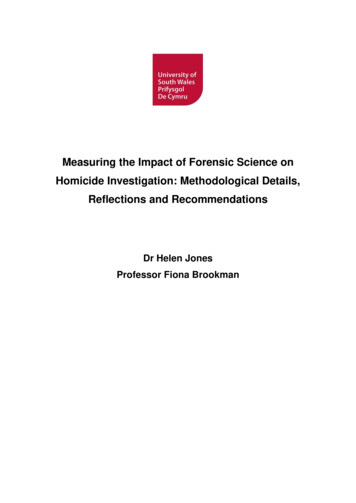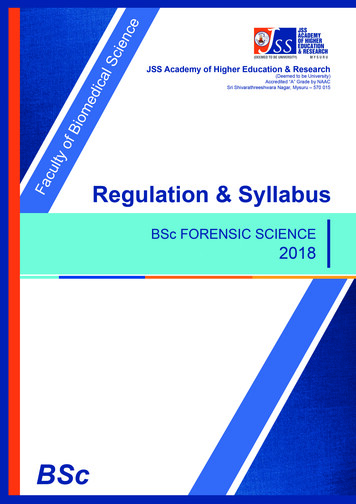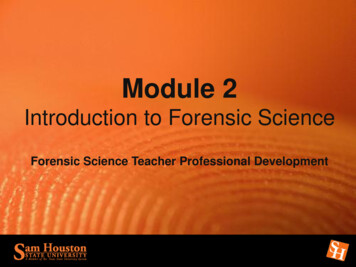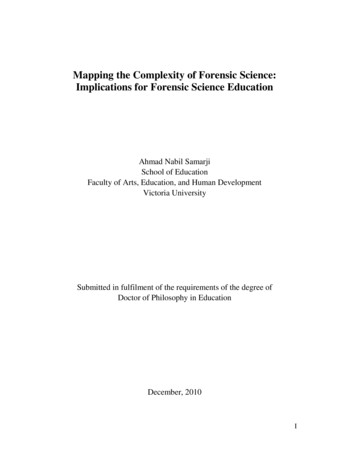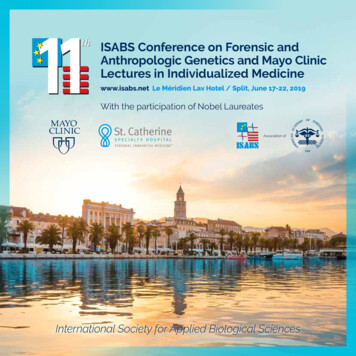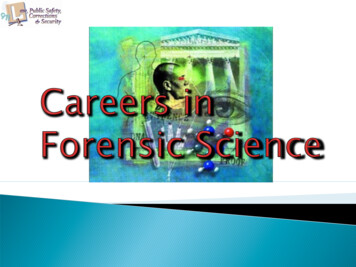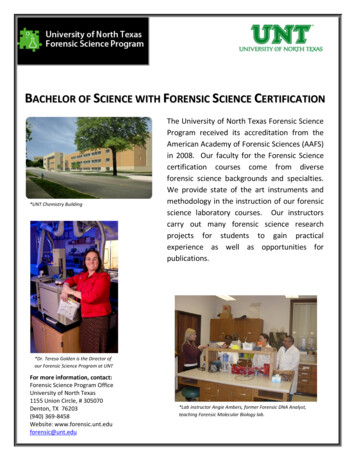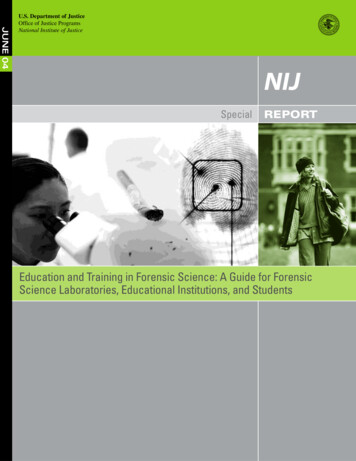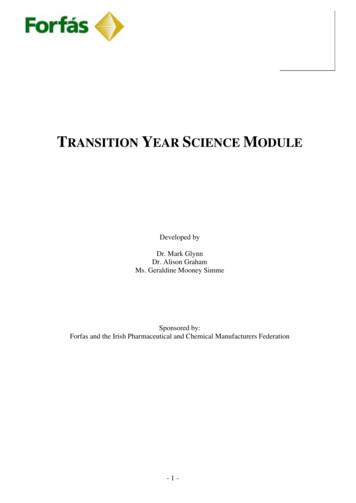
Transcription
TRANSITION YEAR SCIENCE MODULEDeveloped byDr. Mark GlynnDr. Alison GrahamMs. Geraldine Mooney SimmeSponsored by:Forfas and the Irish Pharmaceutical and Chemical Manufacturers Federation-1-
Although every effort has been made to ensure accuracy of the material enclosed, completeaccuracy cannot be guaranteed. All or part of this material may be reproduced without furtherpermission provided the source is acknowledged. Electronic copies of the modules may beobtained via www.ipcmf.ie or by contacting the IPCMF on 01 605 1581-2-
Students who do Transition Year get better grades in the Leaving Cert than those who don't.This claim was already made two years ago by the National Council for Curriculum andAssessment (NCCA), following a survey which revealed that students who took TransitionYear achieved 42 additional CAO points compared to those who went straight into theLeaving Cert programme.The claim is now further substantiated by a new report from the Economic and SocialResearch Institute (ESRI), which states that students who do the extra year show an averageincrease of eight per cent in Leaving Cert grades over those who skip the year. The findingsare based on the Leaving Cert results of 1996 Junior Cert students, with the trend most evidentin maths and English. The aim of this program is to provide science based resources suitablefor the Transition Year curriculum. Transition Year is an ideal opportunity for students to gainexposure to extremely interesting aspects of everyday science that may not be on the JuniorCertificate of Leaving certificate syllabus.This programme will contain five distinct modules:Forensic Science (January 2004)Chemical Engineering (February 2004)Sports Science (March 2004)Cosmetic Science (April 2004)Environmental Science (May 2004)Each module cover a range of topics and recommend suggested practicals inaddition to material suitable for the classroom. This programme also includes avariety of science based topics suitable for public speaking seminars.We acknowledge this programme is in its infancy and welcome your feedbackno matter how critical.Yours sincerely,Mark GlynnEducation OfficerIPCMF-3-
By the end of this module you should:1. Know what a forensic scientist does2. Know what qualities and training isrequired to be a forensic scientist3. Have experienced what it is like towork as a forensic scientist on amurder enquiry-4-
What inspired youto enter thiscareer?I had done a degree and someresearch in Chemistry but Iwanted to apply what I knewto real lifeWhatqualities doyou need tosucceed?Technical skills- to carry outtests and comparisonsaccuratelyObservation skillsimportant evidence is easilyoverlookedGood judgement about whatis importantOrganisational skills- thereis always too much to do!Communication skills tocommunicate scientificevidence to a non-technicalaudienceWhat advice would you giveto someone choosing L.C.subjects who may wish tofollow a career in ForensicScience?Physics, Chemistry, andBiology are all usefulfollow your interests and geta good basic science degreeor technical qualificationA typical dayin the lifeof a forensicscientist9.00 Go through notes on acase coming up in court laterin the day. Fragments of glassfrom a suspects clothes havebeen matched with a brokenwindow in a burglary case10.00 Urgent call from Gardaito take samples of paint fromthe clothing of the victim of ahit and run accident11.00 Organise chemicalanalysis of paint andfragments of glass also foundon the victims clothes14.00 Consult data base inGermany and identify themake and colour of the carReport back to Gardai16.00 Give evidence in courtFor entry at technicianlevel- an NCEA qualificationin technical scienceFor entry at professionallevel- a degree in Chemistry,Biology, Molecularbiologybut in practice manyentering at this level havehigher degrees (M.Sc.,Ph.D.)What is thecareer structureafter initialqualifications?Technicians can progressthrough Technician Gradeto senior technician Class1 and 2HighsThe direct application ofscientific informationgenerated making a genuinelyvaluable input into the justiceprocessLowsFrustration of trying to jugglepriorities between thepotential of the evidence andkeeping within budget!-5-Those entering atProfessional level canprogress from Grade 3 toGrade 2. At this stage theymay decide to developtheir career inmanagement ( Grade 2and Grade 1 )
Career 1Skills/QualitiesNeededPro s,Advantages,Good PointsCons,Disadvantages,Bad pointsLeaving Certsubjectsadvisable3rd LevelQualificationrequired-6-Career 2
Questionnaire Is Forensic Science for YOU?1. Which of these is most like you?a. I am good at getting the big picture and I don t get bogged down in detailsb. Details fascinate mec. I like to carry out a routine methodically.2. What kind of puzzles do you like?a. I don t understand why people like puzzle games.b. I prefer jigsaw and logic type puzzlesc. I like action games and puzzles like computer games3. My CDs are.a. In my room, the sitting room, my schoolbag or loaned to friendsb. In a rack, but not in any particular orderc. In a rack arranged in alphabetical order4. In your house, when is the bin collection?a. I have no idea which is bin collection day.b. It s a different day each weekc. I know which day is bin collection day, its5. When you re asked to speak in front of the class, which is most like you?a. I love it, once I get started I can t stop!b. I am usually brief and to the point.c. I really don t enjoy it I go red and forget what I was going to say6. Is your bedroom (at this moment) . . . .a. Tidy everything put away in its place?b. A total mess it s hard to walk over to the bed?c. Something in between7. Which of these sayings do you agree with most?a. Too many cooks spoil the broth.b. Many hands make light work.c. Two heads are better than one.8. When doing projects.a. I like working on my own. Other people annoy me when they don t pull theirweight, and I take pride in my own workb. I like working in a group, you can share work around so that you each have lessto doc. I prefer groups different people can do different tasks depending on whatthey re good at.9. How often do people ask you to explain homework to them?a. Every dayb. Once a weekc. Never10. Were the boxes on the previous page.don t look back!!a. same width, variable heightsb. same width, same heightc. variable width, same height-7-
Results of QuestionnaireAllocate marks according to then scheme below1. Problem solving skillsQ1 a 2 b 3c 1Q2 a 1 b 3c 22. Observing skillsQ4 a 1 b 1c 3Q10 a 3 b 1c 13. Organizational skillsQ3 a 1 b 2c 3Q6 a 3 b 1c 24. Team-working skillsQ8 a 1 b 2c 3Q7 a 1 b 2c 35. Communicating skillsQ9 a 3 b 2c 1Q5 a 2 b 3c 1Results:Total PointsIs forensics for you?25-30You have all the skills you need to have the potential to becomean excellent forensic scientist. This is certainly a career optionfor you20-25A few skill areas still need development, but you have definitelygot what it takes to be a forensic scientist15-20Not sure that forensic science is for you. You have not shownthe skills you need in this questionnaire10-15There are lots of careers in science other than forensics. Try oneof them!-8-
Forensic Scientists and detectives work closelytogether to solve crime. You are going to take on therole of these to solve the dastardly crime in DelahaseyHouse.As a forensic scientist the techniques available to you are shown on thenext page. Some you can do yourself. Others you must send away for, and socost you tokens (You may be given a limited number of tokens, OR the winneris the one who solves the crime with the least number of tokens). Work out asystem of solving the crime without wasting resources!A few hints:1. Start by looking through what evidence was collected by the forensic teamat the scene, and the statements collected by the Gardai. They havenarrowed it down to five suspects, but now they are stuck.2. No one type of evidence will give you the murder. You will need togradually rule out the suspects until you are sure of who is guilty.3. Record all your results meticulously on your master sheet.4. Start with the analysis techniques that you can do yourself.5. Remember that you can never get a conviction without corroboratingevidence-9-
Chemical Analysis(See Worksheet 1 & 2)Refractive Index of GlassRefractive Index is ameasure of how much asubstance bends light.Different types of glasswindow, headlight,reinforced, etc. all havedifferent refractive indexes,which can be measured byimmersion in oils ofdifferent known refractiveindex when it is the as thefragments of glass theydisappearChromatography(See Worksheet 3)ForensicScientistInfrared Spectrometry (IR)Different bonds in a molecule absorb infraredlight at different wavelengths. Each compoundtherefore has its own unique infraredspectrum. By comparing spectrum of theunknown substance with known spectra ofknown substances the unknown substance canbe identified.- 10 -DNA ProfilingDNA is a chemical that makes upchromosomes. The genetic code we carryin our DNA is unique to each individual. Ingenetic profiling:1. The DNA is isolated from ablood/semen sample & copied tomake more of it2. It is then treated with restrictionenzymes which break the moleculeinto fragments in certain placesaccording to the code3. The fragments are separated byplacing an electric field acrossthem, the smaller fragments movefaster4. The DNA fragments are madevisible as bands. The combinationof bands in each individual isunique
Murder in Delahasey HouseReport from Detectives & Forensic Scientists called to the sceneI arrived at the house at 2:30pm, after a 999 call at 2:07pm. James was in his pottery studio. Hehad been shot at point blank range. There was a suicide note and pen citing business difficultiesas his reason for taking his own life. He was lying beside a chair he had been sitting in. Therewas broken glass on the floor - probably from a wine glass. He was found by his daughter andhousekeeper who live in the house. Other people present in the house were the gardener, JimPeel and a handyman, Paul Mahon. Mr. Murphy s son, Sean, lives nearby, and arrived soonafterwards.Report from Forensic ScientistEvidence from scene:1. Glass broken beside body, and glass particles from shoes of suspects (refractive index)2. Finger prints from gun none the dead man was not wearing gloves.3. Threads navy blue collected from chair opposite the table where Mr. Murphy wasworking when shot, and samples of threads from navy blue garments belonging tosuspects (IR)4. Sample of ink from the suicide note, and sample of ink from pens belonging to thesuspects (chromatography)5. Sample of dirt from the floor of the studio, and sample of dirt from the shoes of suspects(chemical analysis)6. Blood samples from the victim, and blood samples from the clothes of the suspects (DNAprofiling)- 11 -
Interview with housekeeper Mrs. DoyleQ: Was Mr. Murphy often in his studio?A:Interview with gardenerQ: Where were you on the day of Mr. Murphy sdeath?A:Q: What happened on the day of his death?A:Q: There are blood spots on your clothesyou explain that?A:canInterview with handyman Paul MahonQ: Tell me about the day of Mr. Murphy s deathA:Q: Did you see anyone arrive or leave the house?A:Q: We found some blood spots on your clothesany idea how they got there?A:Interview with son Sean MurphyQ: How did you get on with your father?A:Q: Did you see him on the day of his death?A:Q: Did you get on with Mr. Murphy? What washe like as an employer?A:Q: Can you think of any possible reason why heshould take his own life? Any businessproblems?A:Q: There are some blood spots on your clothes,can you explain that?A:Interview with daughter Rebecca MurphyQ: How did you get on with your father?A:Q: Where were you on the day of his deathA:Q: We have found some blood spots on your clothesA:could you tell us how they got there?- 12 -
SuspectsTechniquesSuspect 1SonSeanMurphyChromatographyInk on suicide noteBlue Yellow RedChemical AnalysisOn dust from shoesCations (flame tests)plaster pottery clay Chemical AnalysisAnionsPlaster Clay Fertilizer IROn navy threads onseat in studioRefractive IndexOf broken glass atsceneDNA Profile- 13 -Suspect 2GardenerJim PeelSuspect 3HousekeeperMrs. DoyleSuspect 4DaughterRebecca MurphySuspect 5HandymanPaul Mahon
Testing for cations (positive metal ions)1. Place wooden splints into a beaker of water (so that they don t burn in the Bunsenflame)2. Dip the damp splint into one of the known samples3. Hold for a short time in a blue Bunsen flame and observe. Record results below4. Repeat for all known samples using a new splint for each sampleResults of known samples:SampleLithium SaltPotassium SaltCalcium SaltResult5. Using new splints for each sample now test the plaster and pottery clay, and thesamples from the shoes of each suspect recording observations and conclusionscarefullyResults of unknown samples:SamplePlasterPottery ClayFertilizerDirt from shoes Suspect 1Dirt from shoes Suspect 2Dirt from shoes Suspect 3Dirt from shoes Suspect 4Dirt from shoes Suspect 5ResultConclusions:What are your conclusions from these tables? Transfer the results to the master sheet.- 14 -
Testing for anions (negative ions)Follow this procedure on known samples of carbonate and sulphate, fertiliser, plaster and clay.Then carry out the same analysis on the purified samples from the shoes of the 5 suspectsPut a small amount of sampleinto a test tube. Add dilutehydrochloric acidDoes it fizz?NOYESThe sample containscarbonateAt barium chloridesolutionDoes a white solid(cloudy) form?YESThe sample containssulphateResults(known samples):SampleCarbonateNOThe sample does notcontain sulphate terClayResults(unknown samples):Suspect 1Suspect 2Suspect 3Suspect 4Suspect 5Conclusions:What have you found out from these tests? Transfer your findings to the master results sheet- 15 -
1. Draw a pencil line about 3cm from the base of 3 pieces of chromatography paper2. Use the droppers/capillary tubes to make spots of ink on the pencil line as shownChromatography paperInk SpotsPencil linesolventIn each case allow the spot to dry and then add another spot to get a very concentratedspot.3. Suspend the chromatography paper in a beaker/gas jar4. Leave until the solvent has almost reached the splint, and compareResults:Sketch your chromatogramsInk from noteSuspect 1Suspect 2Suspect 3Suspect 4Suspect 5Conclusions:What conclusions can you draw from these experiments? Transfer the results to the mastersheet.- 16 -
1. Who do you think is the murderer. Give reasons for your choice.2. For each of the other suspects explain clearly why you think the evidence indicatesthey are NOT the culpritSuspect ( ):Suspect ( ):Suspect ( ):Suspect ( ):- 17 -
- 18 -
Lesson(40 n what is themodule all about?Read sheet on ForensicScientistFill in career informationsheetDo Questionnaire, workout resultsEquipment RequiredChemicals RequiredPhotocopyStudent MaterialPg. 1-15(1 per group)Introduction to the murderTechniques available to aforensic scientistFlame testsPer group: 10 splints, beakers,water, Bunsen, Safety GlassesTests for Carbonates andSulphatesPer Group: Dilute HydrochloricAcid(circa 0.2M), Bariumchloride solution (circa 1Mdissolve 50g BaCl2.2H2O in200cm3 water)Per group: Beakers x2/3Chromatography paper, woodensplintsChromatography- 19 -Lithium chloride, Potassium chloride,strontium nitrate, calcium chlorideLabelled: plaster calcium sulphatepottery clay potassium chloridefertilizer potassium sulphatesuspect 1 potassium chloridesuspect 2 potassium sulphatesuspect 3 potassium chloridesuspect 4 potassium chloridesuspect 5 strontium/calcium sulphateLabeled carbonate calcium carbonateLabeled sulphate potassium sulphatePlaster, pottery clay, fertilizer and suspect1-5 as shown aboceLabeled: Suicide note Ink yellow redfood colouringsuspect 1 Mixture as abovesuspect 2 Ink onlysuspect 3 Mixture as abovesuspect 4 Mixture as abovesuspect 5 Mixture as above
5Buying results ofRefractive index, DNA, IRComing to conclusionsWriting Report6Communicating reportto class in groupQuestions from classPhotocopy 12 setsof results whichcan be bought (1per group)(pages 21-23)20 copies oftoken (page 20)- 20 -
SuspectsTechniquesSuspect 1SonSeanMurphyChromatographyInk on suicide noteBlue Yellow RedChemical AnalysisOn dust from shoesCations (flame tests)plaster pottery clay fertiliser Chemical AnalysisAnionsPlaster Clay Fertilizer IROn navy threads onseat in studioRefractive IndexOf broken glass atsceneDNA Profile- 21 -Suspect 2GardenerJim PeelSuspect 3HousekeeperMrs. DoyleSuspect 4DaughterRebecca MurphySuspect 5HandymanPaul Mahon
1Token1Token1Token1Token1Token-exchange for 1test result-exchange for 1test result-exchange for 1test result-exchange for 1test result-exchange for 1test resultExchange 5 tokensfor 1 complete set ofresults (5 suspectsplus murdervictim/sample atsceneExchange 5 tokensfor 1 complete set ofresults (5 suspectsplus murdervictim/sample atsceneExchange 5 tokensfor 1 complete set ofresults (5 suspectsplus murdervictim/sample atsceneExchange 5 tokensfor 1 complete set ofresults (5 suspectsplus murdervictim/sample atsceneExchange 5 tokensfor 1 complete set ofresults (5 suspectsplus murdervictim/sample atscene1Token1Token1Token1Token1Token-exchange for 1test result-exchange for 1test result-exchange for 1test result-exchange for 1test result-exchange for 1test resultExchange 5 tokensfor 1 complete set ofresults (5 suspectsplus murdervictim/sample atsceneExchange 5 tokensfor 1 complete set ofresults (5 suspectsplus murdervictim/sample atsceneExchange 5 tokensfor 1 complete set ofresults (5 suspectsplus murdervictim/sample atsceneExchange 5 tokensfor 1 complete set ofresults (5 suspectsplus murdervictim/sample atsceneExchange 5 tokensfor 1 complete set ofresults (5 suspectsplus murdervictim/sample atscene- 22 -
DNA Profiling ResultsDNA Profiling ResultsJames Murphy (deceased)Suspect 1DNA Profiling ResultsSuspect 2 DNA Profiling ResultsDNA Profiling ResultsDNA Profiling ResultsSuspect 3Suspect 4Suspect 5 - 23 -NONE
Refractive Index ResultsRefractive Index ResultsAt Crime SceneSuspect 1Does not match glass atcrime sceneBroken Wine GlassRefractive Index ResultsRefractive Index ResultsSuspect 3Suspect 4Does not match glass atcrime sceneMatches glass at crime scene- 24 -Refractive Index ResultsSuspect 2Matches glass at crime sceneRefractive Index ResultsSuspect 5Does not match glass atcrime scene
Evidence from IRIR from threads in seat at murder sceneIR from threads from suspect 1IR from threads from suspect 3IR from threads from suspect 4- 25 -IR from threads from suspect 2IR from threads from suspect 5
Forensic Science (January 2004) Chemical Engineering (February 2004) Sports Science (March 2004) Cosmetic Science (April 2004) Environmental Science (May 2004) Each module cover a range of topics and recommend suggested practicals in addition to material suitable for the classroom. This programme also includes a
